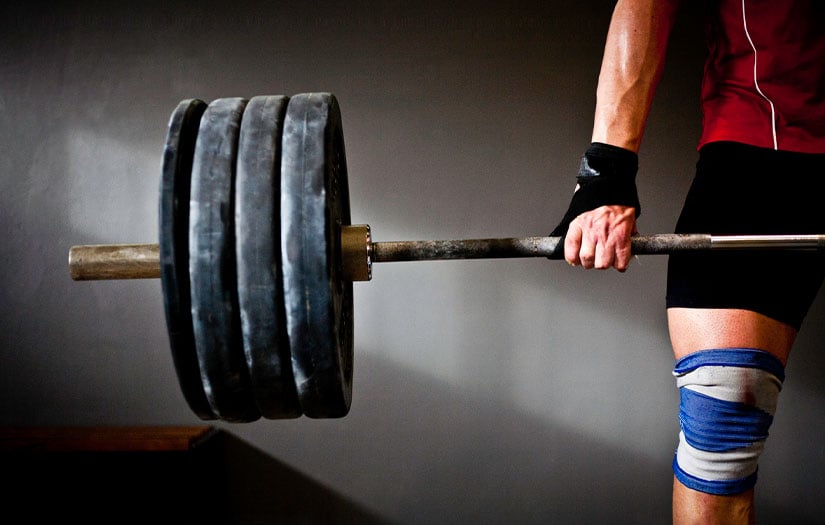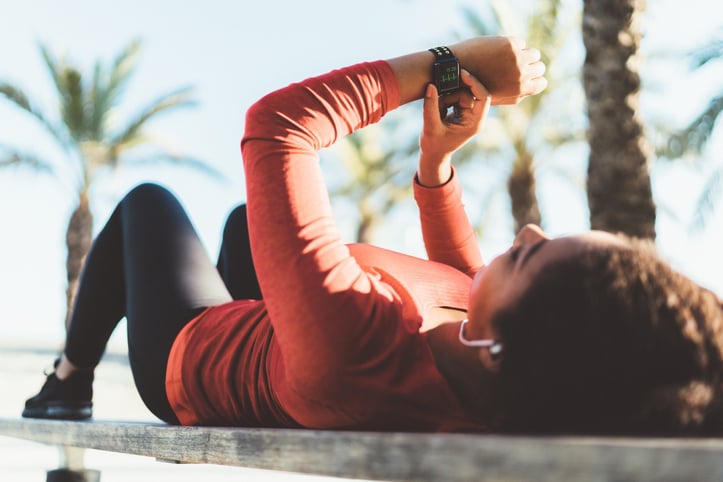This blog was updated on February 23rd, 2022 with contributions made by NASM Master Instructor Kinsey Mahaffey.
Olympic lifts and their variations have long been used as a strengthening technique to enhance sports performance.
The use of Olympic weightlifting is evident as regular practice by collegiate and professional strength coaches, and supported in refereed journals (1,2,3,4). As sports performance professionals become more knowledgeable and skilled in designing sport specific programs, more information regarding Olympic lifting is necessary in order to help them best serve their athletes.
Let's first look at some olympic lifts and their derivatives that even beginners can do!
7 Olympic Weightliting Movements & How to Do Them
In the sport of Olympic weightlifting, there are only two lifts: the snatch and the clean and jerk. Derivatives of these lifts are more broadly used by athletes and fitness professionals and will be included in the exercise breakdowns below.
Derivative Olympic Lifts
(1) Front Squat
(2) Deadlift
(3) Hang Clean
(4) Push Jerk
(5) Power Snatch
Main Olympic Lifts:
(6) Clean and Jerk
(7) Snatch
Olympic lifts and their derivatives are advanced in nature due to the level of mobility, flexibility, posture control, neuromuscular control, and skill required to perform them. It's not recommended that someone just starting a fitness routine attempt these lifts, but rather someone who has built a solid foundation of stability and strength by training in and completing at least Phases 1 and 2 of the NASM OPT Model.
Derivatives of Olympic Lifts:
If your client is completely new to Olympic lifts, these derivative movements will be an excellent place to begin in developing the skills they will need to tackle some of the more complex movements. Although each lift below is taught using a barbell, you can use other equipment like sandbags, kettlebells, and dumbbells to practice and perform the movements.
Exercise #1 Front Squat
• Hold the barbell in a front rack position, with the elbows high and the chest up tall.
• Stand with feet hip to shoulder-width apart.
• Brace the core, keep the chest tall, and the head in neutral as you lower into the squat.
• Keep knees in line with toes the entire movement and squat as low as you can without losing form.
• Squeeze the glutes as you stand, returning to a tall standing position.
Exercise #2 Deadlift
Set up:
• Step up to a loaded barbell (or a barbell that's elevated on a rack without weight for a beginner!) so that the bar is over your shoelaces, close to your shins. The feet should be straight ahead.
• Bend to grab the barbell with an overhand grip, hands just outside of the knees.
Think about investing in shoes specific for deadlifting and weightlifting in general too!
Tighten up:
• Flatten your back and set your lats by pulling the shoulder blades down and back. It's as if you're pulling the bar in and up, without it lifting off the ground. This is sometimes called "taking out the slack" of the bar.
• In this position, your hips should be lower than your shoulders, and your back flat.
Lift:
• Inhale, and brace your core before lifting the weight up. Your hips and back should rise simultaneously (don't lift the shoulders first, or the hips up first, or you risk using the wrong muscles).
• Squeeze your glutes as you lift and especially as you stand tall at the top of the movement.
• Keep the barbell close to your body during the entire movement and reset between deadlifts to ensure good form.
Exercise #3 Hang Clean
• You can lift the bar off a low rack or off of the floor to begin.
• Stand tall while holding the barbell with an overhand grip, hands just outside of the legs.
• Keep your core tight and back flat as you hinge forward, sitting the hips back and slightly bending the knees. Hinge until the bar is at mid-thigh.
• Thrust the hips forward explosively so that you explode from hinge to triple extension (hip extension, knee extension, and plantar flexion) to give the bar upward momentum as you shrug and bring the bar up.
• Catch the bar by landing in a quarter squat underneath the bar, elbows high in the front rack position, and then stand tall after the catch to finish the move.
Progression: Power Clean
• The movement and the catch of the power clean are the same as the hang clean, the only difference is that you start from the floor, making it more difficult.
• Perform this movement starting with the barbell on the ground. Set up as you would for a deadlift, and then lift the bar while keeping the core braced and back flat (just like the deadlift).
• Once the bar is at mid-thigh, the hips move forward and the knees re-bend slightly to create an eccentric load before you perform the powerful hip thrust as you did in the hang clean.
Exercise #4 Push Jerk
• Stand with feet hip-width apart, toes straight ahead, and the barbell in a front rack position.
• Brace your core for movement as you bend the knees to load eccentrically.
• Forcefully drive up from the legs to give the bar upward momentum as you press it straight overhead.
• Get under the bar and keep the core braced as you lock out your arms overhead. Stand up straight while holding the bar, keeping the abs and glutes tight.
• Slowly lower the bar down to return to the starting position.
Exercise #5 Power Snatch (lower squat in the reception of bar)
• The barbell will start at mid-shin (this can be achieved with a loaded barbell or an elevated barbell without weights added)
• Stand with feet hip-width apart, barbell against the shin, and a wide overhand grip.
• *Pro-tip: To choose the correct hand placement, measure the distance from the left middle fingertip to the right elbow when the arms are held out to the sides of the body, like a wingspan.
• Take the slack out of the bar (like you did to prepare for deadlifts), brace your core, and lift the bar just past the knee.
• Lift the bar higher, between the mid-upper thigh and the pubic bone, and re-bend the knees to shift the weight to the balls of the feet and eccentrically load.
• Explosively extend the hip, knee, and ankle to propel the bar upward forcefully.
• Bend the elbows as you pull the bar up, getting it above your head as quickly as you can while you drop into a quarter squat to get underneath to catch the bar. Arms will be straight in this catch position, with the bar straight up in the air, head in front of the bar.
• Rise to a standing position, keeping the abs tight and arms straight.
The Traditional Olympic Lifts:
Ensure that your client has excellent mobility, flexibility, and neuromuscular control before performing these movements.
Exercise #6 Clean and Jerk
Here, we are combining the Power Clean (while adding a deeper squat in the catch) and the Push Jerk movements.
Perform the Power Clean as described above, but land in a full squat position as you catch the bar in the front rack position.
• Stand to get ready for the jerk. Feel free to re-set your grip at this point, as needed.
• Tighten the core before performing the dip and drive to explode the bar overhead.
• Catch the bar overhead with legs split in a shallow lunge.
Exercise #7 Snatch
This move is performed almost exactly like the Power Snatch until you get to the catch.
• In the catch, drop underneath the bar into a deep squat.
• The lift is considered complete when you stand up straight, with the barbell overhead and under control.
How to Increase Power and Explosiveness for Olympic Lifts
Olympic lifts are powerful in and of themselves, so sometimes more practice allows for a cleaner lift, which can yield more power and explosiveness. In addition to practicing the lift, you can train the underlying movement pattern that makes these lifts so effective for sports training: the hinge. Training in Phase 5 of the OPT Model: Power Training, will produce these results.
Sample Hinge Power Superset:
Perform the kettlebell swings immediately following the deadlifts. Each exercise should be performed as quickly as possible with good form.
| Exercise | Reps | Sets | Rest |
| Deadlift | 1-5 (Max Strength) | 3-5 | 0 |
| Kettlebell Swing | 8-10 (Power) | 0 | 1-2 Minutes |
Olympic Lifts Versus Powerlifting
Olympic lifting and Powerlifting are both sports that require specific movements in their competitions. The Olympic Lifts, as we've already covered, are the Clean and Jerk and the Snatch. Powerlifting athletes compete using Bench Press, Squats, and Deadlifts.
Sample Olympic Lift Workout Program Phase 4, and 5
A note on programming: It's wise to begin training the common movement patterns that you will need to master during Olympic lifts. In the earlier phases of the OPT model, consider training the squat, hip hinge, and overhead press movements to prepare for these lifts.
Olympic lifts are appropriate for phases 4 and 5 of the OPT Model. In Phase 4, you can begin to teach your client how to perform the Olympic lifts using lighter weight during the skill development portion of the workout (before resistance training).
Once your client has progressed and is ready for Phase 5 training, here's a sample resistance workout to try:
| Exercise | Reps | Sets | Rest |
|
Deadlift Hang Clean |
5 (Max Strength) 10 (Power) |
4 |
0 1-2 Minutes |
|
Seated Cable Rows Medicine Ball Pullover Throw |
5 (Max Strength) 10 (Power) |
4 |
0 1-2 Minutes |
|
Front Squat Jump Squat |
5 (Max Strength) 10 (Power) |
4 |
0 1-2 Minutes |
|
Military Press Push jerk |
5 (Max Strength) 10 (Power) |
4 |
0 1-2 Minutes |
Olympic lifts can be fun, challenging, and they produce great results when performed well and applied properly.
Before designing an Olympic lifting program, it is important for sports performance professionals to understand the scientific rationale and effectiveness of the Olympic lifts.
Designing Olympic Weightlifting Programs
Olympic weightlifting is technically a sport in which competitions are held locally, nationally, internationally and most notably at the Olympics. The competition lifts are the snatch and the clean & jerk. While Olympic weightlifting is a sport, the lifts themselves are commonly used by sports performance professionals to help their athletes improve elements of athletic performance such as strength and power. Furthermore, even more popular among athletes and strength coaches are the variations of the competition lifts such as the power snatch and power clean (5). Variation lifts are more widely used because many athletes cannot achieve the deep squat position necessary of the snatch and clean & jerk (5,6).
The power clean and power snatch are preferred because the catch position (receiving position) is performed from a 1/4 squat rather than a full squat position. Pulling derivatives such as the clean pull and snatch pull may also be preferred because the emphasis on triple extension (ankle plantarflexion, knee extension, and hip extension) and explosiveness is still stressed, but these lifts do not require the athlete to learn the intricacies of the catch position (6). To learn more about performing and properly assessing if athletes are functionally capable to perform Olympic lifts safely and efficiently see NASM’s specialization for sports enhancement (NASM-PES).
SAID Principle in Olympic Weightlifting
When designing a program for enhancing sports performance, one of the most important acute variables sport performance professionals must consider is exercise selection (5). All exercises chosen should follow the Principle of Specificity also known as the SAID Principle (Specific Adaptation to Imposed Demands). The SAID Principle essentially means the body will adapt to the type of demands placed on it.
For example, if an athlete continuously lifts heavy loads, the adaptation will be maximal strength. Conversely, if the athlete continuously lifts light loads with high repetitions, the outcome will be muscular endurance. This is a fairly simple concept to understand. In essence, you get what you train for.
A majority of sports require explosive power (strength + speed) in order to play up to full potential. While the Olympic lifts do not mimic many specific sport skills such as running, throwing, or catching, they do develop the specific adaptation of explosive power. Power is the ability of the body to produce the greatest amount of force in the shortest possible time. This is represented by the simple equation; force × velocity.
The two Olympic lifts and their derivatives have been shown to increase velocity of movement and rate of force production (2,3,4). In fact, the second pull of the power clean exhibits one of the highest power outputs of any resistance training exercise (5,7). Additionally, maximum strength (force) can be enhanced by performing Olympic weightlifting variations such as heavy squats, deadlifts, and presses (5,8).
Thus, it is safe to say, Olympic lifts and their derivatives adhere to the SAID principle and can be an effective exercise selection for enhancing overall power and athletic performance (as long as the athlete possess the functional capabilities to perform these movements) (5).
The Universal Athletic Position
As mentioned earlier, Olympic lifts do not mimic many specific sport skills such as running, throwing, or catching. However, one static/dynamic posture Olympic lifts do mimic often seen in athletics is the Universal Athletic Position (5). This position is described as standing in a quarter squat with feet flat, the hips are behind the center of gravity, shoulders are in front, the torso is flat (inclined at an angle of about 45º) weight distributed on a full foot, hands in front, knees over the toes, and shoulders over the knees (5).
The Universal Athletic Position is generally regarded as the most common position in all of sports (5). In some cases, it is used as a static “ready position” such as a linebacker waiting for a play to begin or a baseball player preparing to steal second base. Other times, the athlete moves through the Universal Athletic Position dynamically (during a countermovement or wind-up) to exploit the stretch-shortening cycle (5).
The Olympic lifts, when performed correctly, move through the Universal Athletic Position between the first and second pull phases allowing the hip extensors and ground reaction forces to explode the bar vertically (5).
Read also: Sports Performance Training - 8 Reasons to Train Athletes
What Does the Research Say?
Now that we have a basic understanding of Olympic weightlifting; what does current research tell us? Can Olympic weightlifting improve elements of athletic performance? While there is no conclusive research study proving Olympic weightlifting improves all aspects of athletic performance, several studies and peer reviewed articles have shown the effectiveness of an Olympic weightlifting conditioning program on various performance measures including jumping, sprinting, and explosive strength.
- Ayers et al. concluded that hang cleans and hang snatches produce similar results for improving vertical jump, back squat strength, and 40-yard sprint times (3).
- Carlock et al. concluded that weightlifting ability and vertical jump performance were strongly linked together (9).
- Channel et al. indicated that Olympic lifts as well as power lifts provide improvement in vertical jump performance. Additionally, Olympic lifts may provide a modest advantage over power lifts for vertical jump improvement in high school athletes (10).
- Chaouachi et al. found that Olympic weightlifting and plyometric training improves force production, sprint times and jumping performance for children ages 10-12 better than traditional resistance training exercises (12). The authors concluded that with proper adult supervision, implementation of all three training styles is warranted to improve performance measure for children (12).
- Hackett et al. illustrated that Olympic weightlifting improves the development of vertical jump height similar to plyometric training (2).
- Hori et al. concluded that performance in the hang power clean is significantly related to jumping and sprinting (11).
Conclusion
Based on the current evidence, there is ample justification to incorporate Olympic lifts into a sports performance conditioning program.
Although no research study can be considered as definitive cause-and-effect, the literature consistently provides enough evidence that Olympic lifts and their derivatives improve rate of force production, high-load speed strength, maximum strength, and vertical jump performance while using dynamic postures (Universal Athletic Position) commonly seen in many sports (5).
The combination of all these factors should improve athletic performance for athletes engaging in explosive sports. However, before implementing an Olympic lifting program it is vital to understand the technical aspects, complexities, and functional requirements for athletes to perform these movements safely and effectively.
References:
- Durell D, Pujol T, Barnes J. A survey of the scientific data and training methods utilized by collegiate strength and conditioning coaches. Journal of Strength & Conditioning Research. May 2003;17(2):368-373.
- Hackett D, Davies T, Soomro N, Halaki M. Olympic weightlifting training improves vertical jump height in sportspeople: a systematic review with meta-analysis. Br J Sports Med. 2016 Jul;50(14):865-72. doi: 10.1136/bjsports-2015-094951. Epub 2015 Nov 30.
- Ayers JL, DeBeliso M, Sevene TG, Adams KJ. Hang cleans and hang snatches produce similar improvements in female collegiate athletes. Biol Sport. 2016 Sep;33(3):251-6. doi: 10.5604/20831862.1201814. Epub 2016 May 10.
- Teo SY, Newton MJ, Newton RU, Dempsey AR, Fairchild TJ. Comparing the Effectiveness of a Short-Term Vertical Jump vs. Weightlifting Program on Athletic Power Development. J Strength Cond Res. 2016 Oct;30(10):2741-8. doi: 10.1519/JSC.0000000000001379.
- Carbone J, Takano B. Olympic Lifting for Performance Enhancement. In Clark M, Lucett S. NASM’s Essentials of Sports Performance Training. Baltimore, MD Lippincott Williams & Wilkins; 2010.
- Suchomel TJ, Comfort P, Stone MH. Weightlifting pulling derivatives: rationale for implementation and application. Sports Med. 2015 Jun;45(6):823-39. doi: 10.1007/s40279-015-0314-y.
- Souza A, Shimada S, Koontz A. Ground reaction forces during the power clean. J Strength Cond Res.. August 2002;16(3):423-427.
- Chiu L, Moore C, Favre M. Powerlifting Versus Weightlifting for Athletic Performance. Strength & Conditioning Journal. October 2007;29(5):55-57.
- Carlock J, Smith S, Hartman M, et al. The Relationship between Vertical Jump Power Estimates and Weightlifting Ability: A Field-test Approach. J Strength Cond Res. August 2004;18(3):534-539.
- Channel BT, Barfield JP. Effect of Olympic and traditional resistance training on vertical jump improvement in high school boys. J Strength Cond Res. September 2008;22(5):1522-1527.
- Hori N, Newton RU, Andrews AW. Does performance of hang power clean differentiate performance of jumping, sprinting, and changing of direction?J Strength Cond Res. 2008; 22:412-18.
- Chaouachi A, Hammami R, Kaabi S, Chamari K, Drinkwater EJ, Behm DG. Olympic weightlifting and plyometric training with children provides similar or greater performance improvements than traditional resistance training. J Strength Cond Res. 2014 Jun;28(6):1483-96. doi: 10.1519/JSC.0000000000000305.
- McGill, E. A., & Montel, I. (Eds.). (2019). Olympic lifting for performance enhancement. In NASM Essentials of Sports Performance Training (pp. 390–411). essay, Jones & Bartlett Learning
















